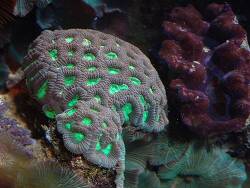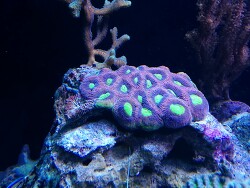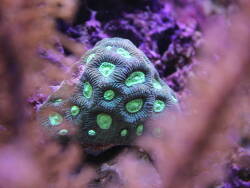Info
Durch eine Information von thor (herzlichen Dank) gelang eine Neuzuordnung.
Es kann sich nicht um eine Favites handeln, sondern vielmehr um eine Favia-Art.
Denn bei dem Bild sind deutlich die getrennten Korallitenwände erkennbar.
Die Identifikation von großpolypigen Steinkorallen ist alles andere als einfach, vor allem bei Favia- und Favites-Arten.
Zu ähnlich sind sie einfach in ihrer Struktur und dem Aussehen.
Die Pflegebedingungen von Favia und Favites sind im Vergleich normal zu sehen.
Sie stellen keine so hohen Anforderungen an die No3- und Po4-Konzentrationen, wie das kleinpolypige Steinkorallen tun.
Dennoch muss man ihnen auch ein ordentliches Umfeld und gute Wasserwerte bieten.
Empfindlich reagieren sie auf Bohr-, sowie Fadenalgenwachstum und sehr schnelle Wertveränderungen (Phosphatsenkung).
Alle Steinkorallen lieben sauberes Wasser, weshalb man unbedingt geeignete Mittel anwenden sollte, um keine Gelbstoffe oder andere Anreicherungen im Wasser zuzulassen.
Licht: Mittel - Boden bis Mittelzone
Strömung: Mittel bis turbulent, niemals direkt!
Futter: lebt vom Licht und den im Wasser befindlichen feinerem Futter (Plankton).
Folgende Arten sind bekannt:
Favia albidus
Favia danae
Favia favus
Favia fragum
Favia helianthoides
Favia lacuna
Favia laxa
Favia leptophylla
Favia lizardensis
Favia maritima
Favia marshae
Favia matthaii
Favia maxima
Favia pallida
Favia rosaria
Favia rotumana
Favia rotundata
Favia speciosa
Favia stelligera
Favia truncatus
Favia veroni
Favia vietnamensis
Es kann sich nicht um eine Favites handeln, sondern vielmehr um eine Favia-Art.
Denn bei dem Bild sind deutlich die getrennten Korallitenwände erkennbar.
Die Identifikation von großpolypigen Steinkorallen ist alles andere als einfach, vor allem bei Favia- und Favites-Arten.
Zu ähnlich sind sie einfach in ihrer Struktur und dem Aussehen.
Die Pflegebedingungen von Favia und Favites sind im Vergleich normal zu sehen.
Sie stellen keine so hohen Anforderungen an die No3- und Po4-Konzentrationen, wie das kleinpolypige Steinkorallen tun.
Dennoch muss man ihnen auch ein ordentliches Umfeld und gute Wasserwerte bieten.
Empfindlich reagieren sie auf Bohr-, sowie Fadenalgenwachstum und sehr schnelle Wertveränderungen (Phosphatsenkung).
Alle Steinkorallen lieben sauberes Wasser, weshalb man unbedingt geeignete Mittel anwenden sollte, um keine Gelbstoffe oder andere Anreicherungen im Wasser zuzulassen.
Licht: Mittel - Boden bis Mittelzone
Strömung: Mittel bis turbulent, niemals direkt!
Futter: lebt vom Licht und den im Wasser befindlichen feinerem Futter (Plankton).
Folgende Arten sind bekannt:
Favia albidus
Favia danae
Favia favus
Favia fragum
Favia helianthoides
Favia lacuna
Favia laxa
Favia leptophylla
Favia lizardensis
Favia maritima
Favia marshae
Favia matthaii
Favia maxima
Favia pallida
Favia rosaria
Favia rotumana
Favia rotundata
Favia speciosa
Favia stelligera
Favia truncatus
Favia veroni
Favia vietnamensis







 alfredundmichaela
alfredundmichaela



















